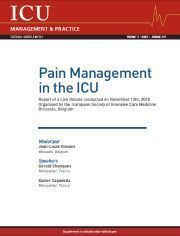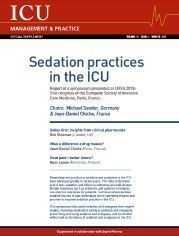Aspen is a global pharmaceutical company with a proud South African heritage. The Group has a business presence in approximately 60 countries and more than 10.000 employees worldwide with an extensive portfolio on thrombosis, anesthesia, high potency & cytotoxics therapeutic categories. Through strategic partnerships, Aspen has established its leadership in the field of anesthesia, offering the market a comprehensive portfolio of credible, high quality solutions manufactured in Europe.
Products
Pain Management in the ICU / Vol. 19, Issue 1
How to manage sedation analgesia for patient-centred care in the ICU
Managing sedation analgesia for patient-centred care in the ICU Pain management and sedation are closely linked in the intensive care unit. In the past, clinicians were using sedative agents too liberally, often with benzodiazepines. And several issues were observed in the ICU, including the problems of delirium, weakness and prolonged ICU course. In recent years, attempts have been made to decrease...
Sedation and Analgesia
How to manage sedation analgesia for patient-centred care in the ICU. In the concept of patient-centered care, sedation and analgesia have high importance. Intensive care is sometimes invasive and very painful. Patients in the ICU are seriously ill and often suffer from anxiety, agitation, and pain. There is sometimes a need to use deep and prolonged sedation, but that can cause other issues which need...
Pain management through multimodal analgesia in the ICU
Overview and focus on regional anaesthesia Opioid dependency is a serious problem in the ICU. Opioids are effective at providing pain relief because they reduce the perception of the pain signal. At the same time, opioids are associated with respiratory depression, cough suppression, confusion, and drowsiness. In addition, there is a risk of abuse and dependence with opioid drugs. Despite these risks...
Concluding remarks
Reducing sedation and managing and treating pain are important objectives for clinicians. The primary goal should always be to promote the comfort of the patient and to minimise pain through the proper use of multimodal analgesia. The use of opioid drugs should be avoided unless absolutely necessary; and focus should be placed on achieving pain control through combined pain management strategies. The use...
Sedation practices in the ICU
Report of a symposium presented at LIVES 2018: 31st congress of the European Society of Intensive Care Medicine, Paris, France Chairs: Michael Sander, Germany & Jean-Daniel Chiche, France Knowledge and practice in sedation and analgesia in the ICU have advanced greatly in recent years. The risks of delirium and of over-sedation and effect on outcomes are well-known...
Safety first: insights from clinical pharmacists
A critical care pharmacist’s perspective and advice on medication safety around sedative and analgesic therapy in the ICU. Medication errors occur at every stage of the drug therapy process. A recent report on medicines processes in English hospitals identified notably high error rates in prescribing (8.8%) and preparation and administration (78.6%) (Elliott et al. 2018). Medication errors in ICU...
What a difference a drug makes?
Asking why the patient needs to be sedated is as important as the choice of drug for sedation. Why use sedation? Intensivists should ask why they use sedation every time they order it. Sedation is used to reduce the burden and stress of critical illness. Sedative agents mixed with analgesic agents reduce pain and keep the patient calm, especially at night. Intensivists need to look for the cause of...
Good past—better future?
From massive sedation in the past, through current sedation practice relying on cooperation between patients and care providers, the future may further improve sedation in the ICU. The concepts for good sedation include defining the range of sedation, the need for agents with rapid response that can be easily and rapidly varied in restless and confused patients, various modes of ventilation, continuous...












